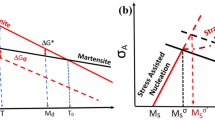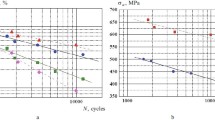Abstract
General features of the damage evolution in cyclic loading of structural materials are summarized. The attention is paid to the comparison of the damage mechanisms in materials that are used for service both at room and at elevated temperatures, namely austenitic stainless steel Sanicro 25. Principal mechanisms leading to fatigue fracture at room and at elevated temperature are documented. While cyclic slip localization is a decisive process in the initiation of fatigue cracks at room temperature, the localized oxidation plays an important role in isothermal high temperature cyclic loading. Specific mechanisms of the early fatigue damage in thermomechanical cyclic loading are studied. The in-phase thermomechanical loading leads to the intergranular crack initiation due to preferred grain boundary oxidation and intergranular crack growth. The out-of-phase thermomechanical loading results in oxide cracking and localized oxidation of the metal in the area of cracked oxides and to transgranular crack growth. The damage mechanisms can explain differences in fatigue life under various loading and temperature conditions.










Similar content being viewed by others
References
Pineau A, and Antolovich S D, Mater High Temp 32 (2015) 298.
Lemaître J, and Desmorat R, Engineering Damage Mechanics. Ductile, Creep, Fatigue and Brittle Failure. Springer, Berlin, Heidelberg (2005).
Arson C, Mech Res Commun 60 (2014) 81.
Antolovich S D, Philos. Trans. R. Soc. A 373 (2015) Article No. 20140128.
Kim Y-J, Jang H, and Oh Y-J, Mater Sci Eng A 526 (2009) 244.
Polák J, Petráš R, Heczko M, Kuběna I, Kruml T, and Chai G, Mater Sci Eng A 615 (2014) 175.
Petráš R, Škorík V and Polák J, Mater Sci Eng A 650 (2016) 52.
Mazánová V, Polák J, To be published (2016).
Polák J, Mazánová V, Kuběna I, Heczko M, and Man J, Metall Mater Trans A, Submitted for publication (2015).
Beck T, Lang K-H, and Loehe D, Trans Ind Inst Metals 63 (2010) 195.
Nagesha A, Kannan R, Parameswaran P, Sandhya R, Rao K.B-S, Singh V, Mater Sci Eng A 527 (2010) 5969.
Christ H-J, Mater Sci Eng A 468–470 (2007) 98.
Acknowledgments
The present work was realized in CEITEC with research infrastructure supported by the Project No. CZ.1.05/1.1.00/02.0068. The support by the Grant No. 13-23652S of the Grant Agency of the Czech Republic and by Project RVO: 68081723 are gratefully acknowledged.
Author information
Authors and Affiliations
Corresponding author
Rights and permissions
About this article
Cite this article
Polák, J., Petráš, R. & Mazánová, V. Basic Mechanisms Leading to Fatigue Failure of Structural Materials. Trans Indian Inst Met 69, 289–294 (2016). https://doi.org/10.1007/s12666-015-0753-z
Received:
Accepted:
Published:
Issue Date:
DOI: https://doi.org/10.1007/s12666-015-0753-z




